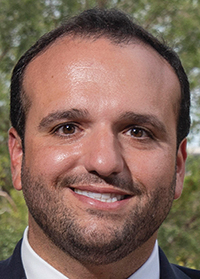Arkansas construction leaders see artificial intelligence (AI) as another tool in the toolbox.
They expect its use will grow and change the industry over the next five to 10 years as the prevalence of data rises. However, they are cautiously optimistic about AI’s widespread use and are testing it to ensure accuracy.
According to Vantage Market Research, the global market value for AI in construction is expected to rise from $594.6 million in 2022 to $4.9 billion in 2030 — a 35.2% compound annual growth rate from 2023 to 2030.
Jon Pahl, corporate innovation director at Nabholz Construction, said the company had tested AI tools over the past 12 to 18 months. The work has primarily regarded data protocols to ensure that workers can trust the information given to and developed by the AI tool.
“We’re at the beginning stages of our journey — wrapping our mind around what the whole market can do for us,” Pahl said. “Construction tech is growing like crazy right now. We’re trying to watch carefully and separate the actual solutions from the shiny objects.”
Pahl believes AI will be a solution as the company determines its best use, including reducing waste, improving decision-making and saving time.

“Machine learning is only as good as the data you give it to learn from,” he said. “As an industry, before we can fully realize the benefits of machine learning, we have some work to do to ensure that our data is clean, trustworthy and centrally organized in some sort of data warehouse.”
Nabholz is testing AI tools in pre-construction. That might include developing plan options for sites, modeling sequences and workflows in schedules, finding the best scheduling solutions, and digitally documenting the project progress.
“With enough images, we can feed an algorithm that will help us understand progress, percent complete,” he said. “There’s even tools out there that can help us scan the photos for safety issues that maybe walking a job site the human eye missed.”
Pahl said Nabholz has been collecting data for a long time and has become more intentional about applying it for the best use of AI tools.
New roles have been created because of AI tools. He said Nabholz has applications analysts who are computer programmers.
“Five, 10, 15 years ago, we would’ve never dreamt of having computer programmers as part of our staff for a construction company,” Pahl said. “But they are integral to tying data sources together to ensure data flows correctly on the back end. All of that results from our … awakening that data is more important than we had given credit to in the past.”
Along with the applications analysts, the company has a growing staff of technology applicators who help roll out new field technologies, including layout and image capture tools. He added that CraneView, a Versatile device, was installed on a tower crane overlooking a Bentonville job site and captured data that the technology team could view.
FAST EMERGENCE
“This AI train is rolling into the station very quickly,” said Derek Alley, CEO of VCC Construction. “It’s exciting and somewhat overwhelming how quickly the tools and the capacity of the tools are expanding.”

In mid-2022, VCC established a task force and has closely followed AI developments. Alley said the company is incubating AI tools to understand how best they might be applied. He expects AI tools to be implemented across every department and industry to improve efficiency and processes, including better building process flow and scheduling.
“These things are critically important in construction,” he said. “We’re dealing with an industry that has massive logistics. We’re dealing with a limited labor force, which we’ve had a labor shortage for many decades now as an industry.”
Recently, DigiBuild used the AI chatbot ChatGPT to source materials for VCC. Alley said DigiBuild uses a blockchain-based procurement model that VCC has been incubating with DigiBuild.
Excluding third-party uses, VCC has fed data to an AI chatbot to create an expediting list in seconds instead of being completed manually with project engineers and staff reading through drawings and specifications.
AI APPREHENSION
Pahl joked that one of the challenges to AI technology adoption is the fear that robots will take over the world.
“We, for centuries, have been a very human-powered industry, and our craftsmen have taken a lot of pride in the work they’ve produced with their hands,” he said. “And the thought of robots coming in and taking those roles is scary to a lot of people. Where we’re looking at robotics, for example, isn’t to take jobs away from craftsmen but to supplement our workforce. Maybe we can use robotics, for example, to help keep workers out of harm’s way to do high-risk tasks.”
He noted that using machines to handle lower-value or repetitive tasks can help to supplement the workforce in a tight labor market. The technology could also be used to do repetitive tasks that require a lot of muscle strain. As a result, workers can focus on higher-value tasks.
Jordan Ligon, business development manager at C.R. Crawford Construction, noted AI’s potential safety and efficiency benefits as the company seeks ways to mitigate safety concerns and rising labor costs. Still, he said construction relies on human judgment and doesn’t believe AI can replace that.

“Technology, specifically AI, has been slower to infiltrate the construction industry than others,” Ligon said. “There is too much liability and safety concerns to rely solely on robots or automated machinery to take over a project. However, AI is impacting the construction industry — primarily improving process efficiency — and we can see some solid potential benefits in safety and quality control.”
Asked whether technology will take over the world, Pahl said people have historically been innovative and found tools to help them to work. If one defines technology as tools to help people work, he expects technology to continue to grow. He doesn’t foresee a time that humans don’t do any work and let machines do it all.
“I don’t see it taking over the world,” Alley said. “I see a world that can be made better by using this tool, one of many tools… This is one of those advances I think will be another tool in the chest.”
However, training and onboarding new technologies will be challenging, “especially when a technology like this is still in some people’s minds … kind of sci-fi,” he said. “It’s becoming real every day.”
BROADER AI USES
Gene Kitsmiller, director of virtual design and construction at Baldwin & Shell Construction, has been using AI to help with daily tasks, such as integrating software. He first used AI-driven design software long before starting there two years ago. The 3D design software can automatically place items, such as electrical outlets, based on code.
Project manager Brett Meek said Baldwin & Shell had used ChatGPT to develop safety topics lists for safety meetings with subcontractors. Meek recently used ChatGPT to gather information on construction standards. He added that when he uses AI tools, such as ChatGPT, he proofs the output to ensure accuracy.
Meek and Kitsmiller also highlighted using the AI-driven Dusty Robotics robot the company operates at job sites. The robot prints building layouts onto concrete slabs like an autonomous chalk line. They likened it to a combination of a battle bot and a printer.
This fall, Arkansas Construction Education Foundation will launch a heavy machinery operator apprenticeship program, allowing contractors and their employees to use AI simulators for heavy machinery training. ACEF Deputy Director Zach Sloan said the nonprofit received a nearly $500,000 state grant to purchase four Caterpillar simulators, providing training to operate excavators and dozers. The Arkansas Office of Skills Development grant also allowed the nonprofit to buy four virtual reality headsets with computers for the training.
Sloan expects heavy machinery to be operated remotely in five to 10 years. He said that would be more prevalent in dangerous work settings, such as mining.
“You’re taking somebody completely out of harm’s way by operating it without somebody being in that cab,” he said. “It’s exciting. I think it’s only going to continue to grow.”


